
CEO & Edit or -In- Chief
Swati Gupt a
Chief V ision Officer
Puneet Agar wal
Managing Edit or
Suhas Vit t al
Cont ent Edit or s
Suhas Vit t al
Hanifa khat oon
Zainab Sayyed
Prachi Gupt a
Design Head
Vanshika Gupt a


CEO & Edit or -In- Chief
Swati Gupt a
Chief V ision Officer
Puneet Agar wal
Managing Edit or
Suhas Vit t al
Cont ent Edit or s
Suhas Vit t al
Hanifa khat oon
Zainab Sayyed
Prachi Gupt a
Design Head
Vanshika Gupt a

Head of Digit al St rat egy,
Deli ver y & Operat ions
Priyanka Gaut am
Communicat ion Manager
Bhumika Nandhani
Digit al Par t ner
Fusionflar e Media
Cr eat i ve Manger
Mayur ee Rast ogi
Development Team
Hradyesh Chatur vedi
Alok Bhade
Naman Hooda
V ideo & Pr oduc t ion Manager
Kush bhalla
Sales & Development Head
Disha Gaut am
Event Coor dinat ion
Disha Gaut am
Hanifa khat oon
Cus t omer Success Manager
Zainab Sayyed
Sonal Mishra


The age of AI has already transformed how we work, think, and innovate. But today, we stand at the threshold of something far more profound - the era of Agentic AI. No longer limited to responding to human commands, Agentic AI systems can perceive goals, make decisions, take autonomous actions, and continuously self-improve.
This is not science fiction. Across industries from finance to manufacturing, healthcare to governance, multiagent AI architectures are orchestrating complex workflows, predicting outcomes, and collaborating seamlessly without human micromanagement. The result? A leap in efficiency, agility, and problem-solving capability that redefines competitive advantage.
Yet, with great autonomy comes greater responsibility. As leaders, we must address critical questions: How do we ensure trust, transparency, and accountability in autonomous systems? What governance frameworks will protect against unintended consequences? And how can we integrate Agentic AI into existing structures without losing human oversight?
In this special edition, we explore the strategic, technological, and ethical dimensions of Agentic AI. You’ll find in-depth analyses, industry case studies, and forward-looking perspectives from thought leaders who are already shaping this autonomous future.
Welcome to the conversation on the next frontier of intelligence where machines are not just tools, but active partners in human progress.
Warm Regards
Swati Gupta CEO & Editor-in-Chief


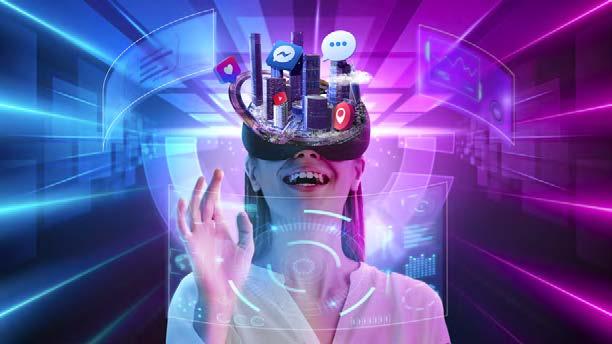











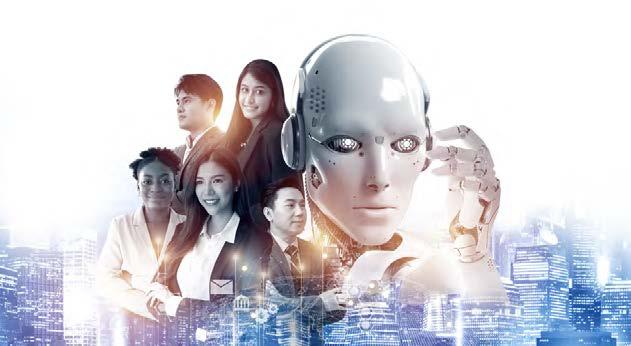








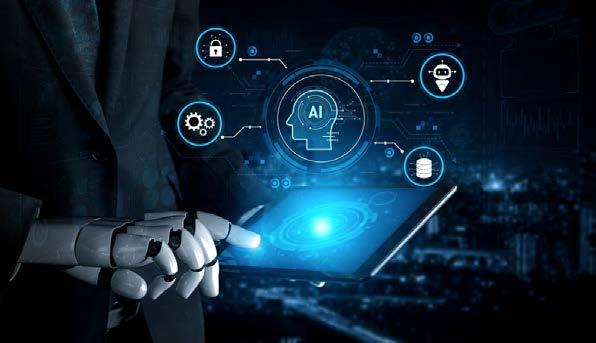



When India unfurled its tricolour in 1947, independence meant political sovereignty. In 2025, as the nation celebrates its 78th Independence Day, a new kind of independence is taking shape -digital sovereignty.
The rise of Agentic AI - autonomous, goal-driven artificial intelligence capable of planning, reasoning, and executing tasks without continuous human prompts is set to redefine India’s public services, industry, education, and governance.
For India, the move towards agentic AI isn’t just technological, it's strategic. It aligns with Atmanirbhar Bharat (self-reliant India), strengthens Digital India, and deepens the country’s position as a global AI hub.
Over the last decade, India has built something no other nation at its scale has achieved - Digital Public Infrastructure (DPI) at a billion-person reach
•Aadhaar: The world’s largest biometric identity system.
•UPI: A real-time payments platform processing over 12 billion transactions monthly.
•DigiLocker: A secure, cloud-based document repository.
•ONDC: An open network for digital commerce.
These platforms form the bedrock for agentic AI. Instead of static portals and human-dependent workflows, agents can now directly connect to these systems to act on behalf of citizens, MSMEs, and enterprisessecurely, instantly, and at scale.
•A personal civic AI renewing your driver’s license automatically before expiry.
•A business compliance agent filing GST returns on time without reminders.
•A social welfare agent proactively enrolling eligible households into government schemes.
This is the shift from digital access to digital action.
Smart Governance – India’s Next Leap
Governments worldwide are experimenting with AI in citizen services. India is uniquely positioned to lead because its platforms already speak a common digital language.
•UMANG 2.0 + AI: A multilingual agent could handle entire permit or certificate workflows application, verification, and issuance without the citizen navigating multiple menus.
•State-level Service Agents: States like Andhra Pradesh, Telangana, and Karnataka could deploy policy agents to monitor scheme utilisation and flag underperformance in real time.
•Urban Automation: Municipal agents could optimise waste collection, manage traffic flows, and issue e-challans autonomously.
This vision is not far-off - pilots in smart cities like Surat and Pune are already integrating AI for traffic and public safety management.

For rural India, agentic AI can be a force multiplier. While the cities will see productivity boosts, the villages will experience access transformation.
•Agri-Advisory Agents: Using satellite imagery, weather feeds, and mandi data, agents could provide farmers with daily advice in their local language from pest alerts to optimal sale timings.
•Market Integration: Connected to e-NAM, agents could auto-match farmers to the best buyers, negotiate prices, and handle logistics requests.
•Rural Health Assistants: AI agents integrated with telemedicine services could proactively schedule check-ups, monitor chronic illnesses via IoT devices, and escalate emergencies to district hospitals.
With over 65% of India’s population living in rural areas, these solutions aren’t just social good, they're economic multipliers.
Industry & Manufacturing – Make in India, Run by AI
Indian manufacturing is entering a high-stakes phase.
Global supply chains are shifting, and Productivity 4.0 is a national priority. Agentic AI could be the game-changer.
•Self-Optimising Supply Chains: Agents can detect port delays, re-route shipments, and renegotiate supplier terms automatically reducing downtime and costs.
•Autonomous Quality Control: Vision agents on production lines can detect defects in milliseconds and feed insights back to machinery, ensuring real-time correction.
•MSME Boost: Smaller manufacturers, often resource-constrained, can use agents to participate in GeM tenders, manage inventory, and auto-generate compliance documents.
With Production-Linked Incentive (PLI) schemes and Make in India driving capital investment, agentic AI could become a core manufacturing productivity layer.
Defence & National Security – Strategic Autonomy
In defence, autonomy isn’t optional, it's mission-critical.
India’s military research arms like DRDO are already exploring AI-based surveillance, logistics optimisation, and cyber defence.
•Border Surveillance Agents: Integrating drone feeds, satellite imagery, and sensor data to detect and flag incursions in real time.
•Cyber Defence Agents: Monitoring government networks 24/7, neutralising malware or intrusion attempts before escalation.
•Logistics Agents: Optimising supply chains for troop movement and equipment in challenging terrains.
Agentic AI in defence directly ties to India’s sovereignty and operational readiness.
Education & Workforce – Preparing for the Agentic Era
India’s youth dividend is both an opportunity and a challenge. The National Education Policy (NEP) 2020 recognises technology’s role in personalised learningagentic AI can make it real.
•AI Mentors: Personalised, adaptive learning paths for each student, tracking progress and adjusting content dynamically.
•Skill Matching Agents: Linking students to internships, apprenticeships, and job opportunities based on real-time labour market data.
•Teacher Assistants: Automating grading, content preparation, and remedial support.
If integrated with platforms like DIKSHA and SWAYAM, these agents could ensure education parity across urban and rural India.
India has pledged Net Zero by 2070 and ambitious renewable energy targets. Agentic AI can accelerate progress:
•Smart Grid Agents: Managing renewable energy integration, forecasting demand, and balancing loads dynamically.
•Environmental Monitoring Agents: Detecting illegal mining, deforestation, or forest fires in states like Uttarakhand and Assam.
•Urban Sustainability Agents: Optimising waste segregation, recycling, and water usage in cities like Indore, which already leads in cleanliness rankings.
These systems create autonomous environmental governance, ensuring sustainability goals are met even without constant human supervision.
India’s AI startup scene is vibrant, with companies building foundational models, vertical AI, and domain-specific agents:
•Sarvam AI: Indian-language large language models for inclusive AI adoption.
•Neysa: Multi-domain agent frameworks for enterprises.
•Cube AI: AI-driven industrial automation.
With Startup India, Digital India, and strong venture capital inflows, these companies could become global leaders in agentic innovation.
By the time India celebrates its 100th Independence Day, the Agentic AI transformation could mean:
•Every citizen has a trusted civic AI that interfaces with all government and essential services.
•MSMEs operate with digital workforces of agents managing supply, compliance, and sales.
• Rural and urban healthcare achieve parity through autonomous care coordination.
•Smart cities and villages run with self-regulating infrastructure.
This is more than a technological vision -it’s a blueprint for a more inclusive, equitable, and resilient India.
The Strategic Imperative
India is at a crossroads. The digital rails are ready. The AI talent pool is growing. The policy momentum is strong.
The “agentic move” will determine whether India becomes just a consumer of autonomous systems or a global exporter of ethical, scalable, and sovereign AI autonomy.




Kumar Gaurav Gupta CEO, Verdantis


Traditional Computerized Maintenance Management Software (CMMS) has been a crucial part of industrial operations, and it has been around longer than one would believe.
The roots of the very first CMMS system can be traced back all the way to the 1960s when work orders, maintenance schedules and spare part inventories were tracked through punch cards.
Shortly after which, Punch Cards were replaced by computer terminals which were adopted by large companies but were still not widely available for organizations with large-scale and complex maintenance requirements.
The widespread adoption of Computerized Maintenance systems, that closely resemble what we use today, can be traced back to the 1970s, when the personal computer was introduced.
Coincidentally, or perhaps not, this is also the time when global manufacturing, particularly in the United States, witnessed its largest ever growth phase, creating immense wealth and solidifying the United States’ position as a powerhouse in global manufacturing.
The extent of impact that CMMS software played in this boom is debatable but there is no doubt that these software systems are a boon to companies in manufacturing, Energy, Minerals & Mining, Utilities and other asset-intensive operations with complex maintenance management requirements.
However, as we progress further into the 21st century, experts and industry leaders have observed the limited pace of innovations in this space.

Today, we’re joined by Mr Kumar Gaurav Gupta, CEO of Verdantis, a known leader in data management software for MRO, that is evolving into a full-service MRO inventory software & CMMS, recently shared his insights on why the industry must rethink its approach to maintenance management.
While traditional CMMS software continues to hold a significant market share, adoption rates are slowing, and its efficacy is being questioned, particularly in industries that require real-time, accurate decision-making.

becoming more frequent."
This signals a critical turning point in how maintenance software is approached. Industries need systems that can manage maintenance as part of a broader ecosystem.
"There’s an urgent need for unified platforms that connect asset management, procurement, supply chain, and even production systems into a seamless experience," he notes.

As industries move towards automation and digital transformation, Kumar is an advocate for AI’s transformative potential in maintenance management.
He asserts that traditional CMMS models are inherently limited in their capacity to process and analyse the huge volume of data generated by modern operations.
"AI can play a game-changing role by enabling predictive maintenance, reducing unplanned downtimes, and optimizing asset performance," says Kumar.
“AI’s ability to learn from historical data, environmental conditions, and even real-time operational changes will allow systems to predict potential issues before they arise- leading to both cost savings and improved operational efficiency."
AI-powered CMMS can also improve decision-making by offering deeper insights into asset health, resource allocation, and preventive maintenance, all of which help businesses make better, more informed decisions.
It’s not enough to simply implement technology - it needs to be future-proof.
“The issue is that CMMS & EAM systems have become too compartmentalized. They’re isolated in silos, managing only maintenance data without integrating into broader business systems,” explains Kumar.
“This means it can't respond to changes in production schedules, demand fluctuations, or global supply chain disruptions, which are
Of course, this requires changes to the current architecture, reliable data and perfect synchronization of that data across disparate systems, but these are challenges we have been able to overcome.
“This shift isn’t just about incorporating AI; it’s about having an AI-driven maintenance model that evolves and adapts as it learns from the data it processes,” Kumar highlights.
The goal with these modern Maintenance Software is to have AI do the heavy-lifting, and reduce human-errors, relegating humans to the capacity of a “Reviewer”
“With AI-driven CMMS and EAM systems, manufacturers can make informed decisions that allow them to quickly adapt to disruptions and mitigate potential risks before they materialize.
Through a combination of Integrated Agentic AI models across Intelligent Document Processing, Spare Parts Inventory Management and Data Management, we’re seeing very promising results as far as accuracy and autonomy in MRO operations is concerned.
The statistics speak for themselves.
The team at Verdantis have crunched the numbers across their product portfolio (detailed below)
•Auto Enrich AI & Spare Seek AI - Autonomous Enrichment and Obsolescence tracker for MRO spare parts, saving months of hours that would otherwise require a subject matter expert to manually correct
•Auto Doc AI - A “context-aware” intelligent document processing solution that can summarize and structure technical documents with a far better accuracy
•Inventory 360 - AI Powered inventory management solution for MRO Spare Parts that can assess criticality of spare parts, fixed assets and autonomously manage inventory levels
•Harmonize & Integrity [MRO Data Management Suite]
Based on assessment reports that have been run on anonymized client data across manufacturing and production-intensive industries, we’re seeing a 20-25% decrease in maintenance costs, driven largely by automations in maintenance procurement and more than 30% decrease in instances of outages and downtime.
In many instances, this number can increase significantly even beyond these thresholds. We can attribute almost all these cost optimization strategies to AI-centric data management and maintenance management solutions
The Path Forward
As businesses move towards a more integrated, data-driven future, the industry needs to embrace the evolution of maintenance management.
The question isn't whether we need a fresh approach, but how quickly we can shift to smarter, more agile systems that can drive value, reduce waste, and improve overall efficiency.
His message is clear: as the world continues to change, so must the tools we rely on.
The age of traditional CMMS is fading, and industries must evolve to meet the demands of the future. AI, clean data, and integrated systems are no longer optionalthey are essential for survival in a competitive global landscape.
In conclusion, "The future is about embracing AI, not just for predictive maintenance, but as a cornerstone of intelligent manufacturing operations. A fresh approach to maintenance management is the key to unlocking the full potential of modern businesses.

Kumar Gaurav Gupta CEO, Verdantis
Kumar Gaurav Gupta is a seasoned professional in enterprise software and the current Chief Executive Officer at Verdantis, a company specializing in enterprise software for Maintenance Management.
Kumar holds a degree from the Indian Institute of Management, Indore, and has held leadership roles at SAP, as the Country Manager for SAP Concur and VP of Strategic Initiatives & Spend Management for the APJ region.
With over two decades of experience leading P&Ls and driving measurable outcomes across industries, he is paving the way for the future of MRO operations with software systems embedded with Agentic AI capabilities.

The AI revolution is no longer just for tech giants with billion-dollar budgets. With the advent of flexible, modular Enterprise GPT platforms, even MSMEs and mid-size enterprises can now access enterprise-grade AI capabilities on their own terms without compromising data privacy, without being locked to a single model provider, and without burning a hole in their budgets.
At www.ailifebot.com, we’ve built an Enterprise GPT platform that changes the way organisations approach AI adoption offering choice, flexibility, and control while making Agentic AI automation accessible for every business size.

One of the biggest barriers to AI adoption is vendor lock-in. Traditional AI platforms tie you to a single LLM, meaning you have to live with its limitations in accuracy, cost, or compliance.
Our Enterprise GPT breaks that pattern by allowing:
•Multiple LLM options - integrate OpenAI, Claude, Mistral, LLaMA, or any other model of choice.
• Offline LLM deployment - run the model entirely within your network for complete data sovereignty.
• SLM (Small Language Model) deployment - perfect for task-specific automation without heavy compute costs.





• Hybrid Model Use - use a large model for creative problem-solving and a small, efficient model for repetitive tasks , all in one ecosystem.
AI adoption fails when it is limited to one department or one use case. Our platform comes with Agentic AI architecture and plug-and-play tools so that:
• HR can automate onboarding, recruitment, and compliance checks.
• Sales can generate personalised proposals and handle lead nurturing automatically.
• Finance can prepare forecasts, track expenses, and flag anomalies.
•IT can deploy automated incident resolution and user support bots.
•Procurement can optimise vendor selection and streamline RFP processes.
•Operations can integrate predictive maintenance and supply chain AI workflows.
Instead of siloed solutions, you get a central AI operating system, a single pane of glass for the entire enterprise.
Most enterprise AI solutions assume users are tech-savvy. We believe AI should adapt to the user, not the other way around.
Our voice-first design allows employees to talk to AI agents in natural language in English, Hindi, or any regional language and get instant, context-aware responses. This is especially impactful for MSMEs where frontline staff may not be comfortable typing long prompts or navigating complex dashboards.
It transforms AI from being an “IT tool” to becoming a daily co-worker for every employee.




Cost - Enterprise AI platforms are often priced out of reach.
Complexity - Lack of internal AI talent makes deployment slow.
Compliance - Data privacy regulations create adoption hesitation.
Our Enterprise GPT solves all three
• Affordable Scaling - Pay for the computer you need; scale as you grow.
• No-Code AI Agent Builder - Business teams can design workflows without coding.
• Privacy-by-Design - Offline LLMs and local deployments keep sensitive data in-house.
This means MSMEs can compete with larger players
growth without overhauling their IT stack.
The Road Ahead – Democratising AI Autonomation
The future isn’t just automation, it's automation. AI agents that understand context, take initiative, and handle tasks end-to-end will be the standard.
With our Enterprise GPT platform, MSMEs and enterprises can
• Start small with one or two AI agents.
• Gradually integrate AI into every workflow.
• Maintain full control over technology choices.
We are not just offering a product, we are offering a pathway to sustainable AI transformation for businesses of every size.
Founder AILifeBOT
Puneet Agarwal is a deep-tech innovator with 25+ years of experience in AI, Voice-First technologies, and Autonomous Agentic Systems. As Founder & CEO of AI LifeBOT, he drives the development of Voice-First AI Agents and enterprise platforms that are transforming governance, customer engagement, and digital ecosystems.
Puneet previously held leadership roles at Microsoft Corp, Avaya Global, Hewlett Packard, HCL, and Adobe India, where he built scalable architectures and enterprise transformation frameworks. This global experience shaped his ability to combine enterprise-grade rigor with frontier AI innovation.
AI LifeBOT’s solutions today serve leading enterprises, government institutions, and public sector organizations, powering deployments across manufacturing, retail, healthcare, FMCG, and BFSI.
Puneet specializes in hallucination-proof RAG architectures, multilingual Voice-First AI, and scalable agentic frameworks.



From Commands to Conversations to Commitments

What “Agency” Means in AI
• •

•
• •
“We no longer just use AI to answer questions. We have agents negotiating energy prices daily, dynamically adjusting our production schedule in real-time. It’s a different mindset entirely.”
Reactive AI (2010–2018)
•
• • The Evolution: From Reactive AI to Autonomous Agents
3. Continuous Compliance
•
•
• Agentic AI (2024 onwards)
•
•
•
•
Strategic Opportunities Generative AI (2019–2023)
1. Autonomous Operations
1.Loss of Control -
2.Security Vulnerabilities
3.Decision Transparency
4.Ethical DilemmasTransformative Risks
“With agents, you’re not just coding You need governance frameworks as teams.”

To successfully harness Agentic AI, enterprises must rethink how they design, deploy, and manage AI systems. The new playbook includes:
• Clear Goal Definition: Agents need measurable objectives to operate effectively.
• Robust Guardrails: Define ethical boundaries, compliance requirements, and escalation triggers.
• Interoperable Infrastructure: Ensure agents can connect with existing systems through APIs and secure data pipelines.
• Continuous Monitoring: Use dashboards to track agent activities, decisions, and performance metrics.
• Human-in-the-Loop Oversight: Strategic decisions and exceptions should still have human review.
The Agentic Shift is not just a technology upgrade - it’s an organisational transformation. Much like the arrival of ERP systems redefined corporate operations in the ’90s, Agentic AI will reshape business models in the 2020s.
The winners in this new era will not be those who simply deploy the most agents, but those who integrate them seamlessly into human workflows, creating symbiotic partnerships between digital and human intelligence.
“The measure of success with Agentic AI isn’t whether the AI can act - it’s whether it can act in ways that make our people and our business better every single day.”
The move from assistant to actor is more than an evolution in capability -it’s a redefinition of what AI is in the enterprise. The question is no longer, “What can AI do for us?” but rather, “What missions can we entrust to AIand how far are we willing to let it run?”
By CXO TechBOT Editorial Team
India’s GCCs: From Cost Centers to Strategic Innovation Hubs—But Are We Ready for M&A?
Over the past two decades, Global Capability Centers (GCCs) in India have evolved remarkably. From their operations and IT support, they have grown into strategic hubs of innovation, engineering excellence, and digital transformation. Today, these centers are delivering cutting-edge R&D, designing global products, and contributing meaningfully to core business outcomes.
But as Indian GCCs take on a more central role in the global enterprise, a crucial capability gap has emerged—the ability to meaningfully participate in and lead the R&D dimensions of mergers and acquisitions (M&A).
I had the privilege of being part of a core team that built a GCC from the ground up for a leading multinational. Our mandate was clear: this wouldn’t just be a support center—it would be an advanced R&D and engineering hub that drives innovation. Over time, we matured the center into a globally integrated capability unit. Then I moved into a global M&A role—and that’s when a crucial realization struck me:


While we had established strong R&D execution capabilities in India, we weren’t prepared to support or lead the R&D aspects of M&A—although these deals are


acquiring startups for innovation, integrating adjacent product lines, or consolidating technology platforms, companies rely on M&A to shape their future. Yet, while India’s GCCs excel at execution and delivery, most are not prepared to contribute to the strategic aspects of
This is a missed opportunity—and a risk.
Many Indian GCCs have invested deeply in technical excellence, Agile practices, and innovation accelerators. However, their focus has remained largely on product they are often excluded from early M&A conversations, particularly those involving technical due diligence, integration planning, or synergy realization, even in the
context of Research and Development (R&D)
Why does this happen? The root causes are simple, yet
•Lack of M&A literacy among R&D leaders
Senior engineers and architects typically lack exposure to the deal lifecycle, R&D in the context of M&A, especially the technical evaluation of products, IP assessments, or architectural compatibility studies.
•Limited visibility into the corporate M&A pipeline GCC teams are rarely looped in during the exploration or negotiation phase, leaving them unprepared for post-deal integration.
•Absence of structured post-merger integration (PMI) capabilities
Even when involved, most centers don’t have formal processes or cross-functional teams ready to support or lead functional integration within R&D functions.
This gap isn’t just academic. It creates a bottleneck during M&A execution, slows down value capture, and reinforces a perception that GCCs are not ready for strategic responsibilities.
In the era of digital convergence, M&A is no longer just a engineering function too.
Consider this: when a company acquires a SaaS startup, the deal’s success often depends on how quickly and seamlessly its products, platforms, and teams can be integrated into the acquirer’s ecosystem. This requires deep collaboration across engineering, product management, IT, and operations.
India-based GCCs, if equipped with the right capabilities, can be ideal partners in this integration journey. Their scale, technical expertise, and growing product ownership make them uniquely positioned to help deliver post-deal value.
But only if they are brought in early, and only if they are ready with M&A skills.
To bridge this gap, GCC leaders must rethink their operating model and invest in new capabilities. This isn’t about turning every engineer into a dealmaker, but about creating awareness, readiness, and alignment with global corporate development functions.
Here’s what needs to change:
Train senior engineers, product owners, and architects in the basics of M&A, particularly around technical due diligence, code base assessments, product road mapping, and architectural integration. This builds strategic conversations.
Create formal mechanisms for the GCC to be informed about potential acquisitions, even in early stages. This allows teams to anticipate integration challenges, align resources, and start preparing for post-deal work.
Establish a Cross-Functional PMI
Build a small, dedicated group within the GCC that includes R&D, IT, HR, and Finance functions. This team
should own the integration playbooks, coordinate local activities post-close, and liaise with global integration teams.
GCC heads should actively build relationships with global counterparts in M&A, product, and technology. Trust and credibility must be earned before a deal lands, not after.
Every deal provides valuable lessons. Capture integration challenges, best practices, and tooling approaches. Over time, this can evolve into a living playbook that accelerates future integrations.
cost center to innovation hub is well underway, but the next leap requires stepping into the strategic core of the business. That means owning not just delivery, but also the transformation of the enterprise itself.
M&A is one of the most powerful levers for business transformation. And if GCCs want a seat at that table, they must be prepared to contribute—not reactively, but strategically.
The next generation of GCCs in India will not be measured solely by the quality of code they write or the features they deliver. They’ll be measured by the strategic problems they help solve—and how well they contribute to long-term value creation.
M&A capabilities, once considered peripheral, are now essential. The future-ready GCC is not just a builder of technology but a steward of business transformation.


Dharmendra Singh
Chief Executive Officer
MergerWare
Dharmendra Singh, Chief Executive Officer at MergerWare, a US-based M&A software firm, has held leadership roles in building a globally integrated R&D GCC in India and later served in a global M&A role, driving cross-functional integrations across technology and product organizations. This unique vantage point informs a practical and strategic perspective on the urgent need to build M&A capabilities in India’s next-gen GCCs.
Digital transformation isn’t just about deploying tools-it’s about orchestrating change. As a CIO with two decades of experience across real estate, banking, telecom, Vehicle finance and consulting, I’ve led multiple enterprise-scale transformations and learned that successful digital journeys are never just technical; they are cultural, strategic, and deeply human.
This playbook brings together real-world insights, strategic imperatives, and battle-tested lessons from implementing Salesforce and SAP across fast-moving, complex environments. Whether you're navigating legacy systems, driving scale, or aligning customer-centric platforms with operational engines, this guide is meant for CIOs and digital leaders aiming to deliver sustainable, scalable & measurable impact.
Start with the “Why” – Strategy Before Software
Before jumping into features, modules, or vendor comparisons, start by clarifying your why. What business problem are we solving? What outcomes do we want to achieve? In my leadership role across digital programs, this clarity helped shape transformation roadmaps that focused not just on automation but on scalability, agility, and resilience.
We began with sector-specific workflow analysis especially critical in industries like real estate where


operations are location-intensive, customer journeys are nuanced, and regulations add layers of complexity. By embedding industry best practices, we avoided over-customization and ensured our systems would adapt, not just survive.
Just as importantly, we conducted a cost-benefit analysis before implementation, ensuring every module, integration, or add-on was tied to real value. This strategic prioritization helped control costs and accelerate ROI.

Choose Partners, Not Just Vendors
Enterprise software success depends as much on the who as the what. I’ve worked with both large consulting firms and niche implementation partners, and here’s what stood out: the best outcomes came when we treated vendors as long-term partners involved early, trusted with strategy, and aligned with business objectives.
Our collaboration model included workshops that brought together sales, marketing, CRM, finance, and project teams, not just IT. This cross-functional co-creation allowed us to scope systems that were fit-for-purpose and future-ready.
We also had to address integration with legacy systems,
which is often the elephant in the room. Rather than rip-and-replace, we took a modular, phased approach, building bridges through middleware, APIs, and data clean-ups, reducing disruption and preserving institutional memory.
Don’t Deploy-Design for Adoption
One of the biggest myths in transformation is that "go-live" equals success. The truth is, adoption is the real milestone. In our Salesforce rollouts, we didn't just install CRM, we reimagined customer journeys. In SAP, we didn’t just configure modules, we simplified daily workflows.
We introduced change champions, department-specific training, and weekly feedback loops. But above all, we
focused on changing user mindsets from “this is IT’s project” to “this is my system.”
That shift transformed passive users into proactive owners, resulting in faster adoption, fewer escalations, and increased trust in technology.
Data Is the DNA- Clean It Before You Scale It
Implementing world-class software on bad data is like building a skyscraper on sand. We invested heavily in data quality improvement before go-live, validating thousands of records, unifying sources, and redesigning dashboards to reflect real KPIs.
We also implemented Role-Based Access Control (RBAC), ensuring sensitive information was safeguarded and team members saw only what was relevant to them. This not only improved security and compliance but also enhanced user experience by decluttering interfaces.
The best digital platforms are built on invisible infrastructure, cloud, cybersecurity, and automation layers that allow everything else to function smoothly.
In our journey, we rolled out cloud migration, Access Control,proxy solutions, endpoint protection, MDM, and ITSM tools for hundreds of users in record time. These foundations created a secure, compliant, and responsive environment, which allowed Salesforce and SAP to operate seamlessly across locations and teams.
This backend standardization also enabled plug-and-play scalability for future modules, partners, and business units.
Every digital investment must lead to clear business outcomes. From license optimization and resource reallocation to automation-driven savings, we continuously tracked Return on Investment (ROI) across each stage of implementation.
Even more importantly, we designed reports and dashboards with KPIs defined upfront. From CXOs to ground-level users, we ensured the system captured and
presented the right data at the right level of granularity driving transparency, performance, and decision-making across the board.
Reporting didn’t begin post-implementation; it was built into the system architecture from day one.
for
No system is ever truly “done.” Businesses change. Teams evolve. Markets shift. That’s why the goal should not be perfection but adaptability.
We adopted an agile transformation mindset, where feedback loops, phased rollouts, and modular enhancements were the norm. By focusing on flexibility over rigidity, we ensured the platforms could evolve alongside the business whether through new geographies, business models, or regulatory needs.
Salesforce and SAP aren’t just systems, they're enablers of change, alignment, and scale. But their success hinges not on how fast you deploy but on how deeply you embed, integrate, and adopt them.
For CIOs and digital leaders, this journey requires a balance of strategy, execution, and empathy because while platforms are built in code, transformation is built in culture.
Done right, digital transformation doesn’t just modernize your IT stack. It redefines how your business operates, decides, and delivers today and tomorrow.
Purvi Shah Chief Information Officer
Purvi Shah is an award-winning CIO and transformation leader with over 19 years of cross-sector experience spanning real estate, banking, telecom, and financial services. Known for her ability to align technology with business strategy, she has successfully led large-scale implementations of Salesforce, SAP S/4HANA, and enterprise platforms that have driven measurable business impact.
Purvi blends deep operational insight with digital innovation, having played a pivotal role in building scalable systems, strengthening cybersecurity, and enabling customer-centric transformation. Her strengths lie in strategic thinking, data-driven decision-making, and change leadership—making her a trusted partner to CXOs and boards alike.
Recognized for her visionary leadership and execution excellence, she continues to drive value through agile delivery, governance frameworks, and a people-first approach to digital growth.



In 2023, a quiet shift began inside boardrooms and innovation labs: enterprises were no longer just exploring AI, they were building their own Enterprise GPTs. These are secure, domain-specific, self-improving AI agents tailored to internal workflows, trained on proprietary data, and capable of reasoning, acting, and evolving with minimal human oversight.
What began with experimentation around ChatGPT quickly matured into a strategic imperative: every enterprise now wants an agentic AI system that understands its context, data, language, and goals, and keeps getting better over time.
This case study explores the rise of Enterprise GPTs through the lens of self-improving AI agents, examining why enterprises are rapidly investing in them, what outcomes they’re achieving, and how tools like AutoGPT, LangChain, and Microsoft’s AutoGen are being leveraged.
Large enterprises adopted generative AI tools like ChatGPT, Bard, and Claude for use cases such as:
• Document summarization
• Email writing
• Customer query handling
• Basic analytics
But soon, limitations became apparent:
• Lack of contextual understanding of enterprise knowledge
• Inability to execute actions (e.g., updating CRMs, triggering workflows)
• Hallucinations due to lack of connection with real-time internal systems
• Repetition of errors without learning from them
• Data privacy and compliance risks with public APIs
“We don’t need a smart chatbot. We need a smart employee that learns, acts, and evolves on our terms, on our infrastructure.”
Solution: Building a Self-Improving Enterprise GPT
Forward-thinking enterprises began building their own Enterprise GPT stacks—AI systems modeled after self-improving agents, capable of:
• Autonomous task planning
• API and tool orchestration
• Self-reflection and performance review
• Contextual memory based on enterprise data
Inspired by open-source tools like AutoGPT, enterprises started creating:
• Sales GPTs to generate personalized pitches, A/B test responses, and refine based on lead conversion data.
• Support GPTs that learn from past ticket logs and auto-resolve 70–80% of tickets without escalation.
• R&D GPTs that scan research papers, track patents, summarize competitor innovation, and evolve their query strategy weekly
• HR GPTs that write and improve job descriptions, score resumes, and learn from final hiring decisions.
Case Example: A Fortune 500 Logistics Firm
Challenge:
The firm struggled with slow procurement cycles, disjointed supplier communication, and repeated manual errors in contract reviews.
Implementation
They deployed an Enterprise Procurement GPT—built on LangChain and OpenAI’s GPT-4—with:
• Fine-tuning on 10 years of procurement data and contracts
• Integrated access to internal tools (ERP, email, calendar)
• Memory of prior negotiations and vendor performance
• Feedback loops to self-correct based on outcomes (missed deadlines, rejected contracts)
Results:
eduction in contract drafting time
Self-improvement cycle triggered weekly via procurement team feedback Enabled 24/7 vendor communication with consistent tone, policy compliance, and real-time data
Data Sovereignty & Security
Enterprise GPTs can be deployed on private clouds or air-gapped servers, with encrypted memory, audit logs, and access controls—unlike public AI APIs.
Tailored Reasoning & Logic
Generic GPTs don’t understand industry-specific logic (e.g., pharma compliance, telecom billing, or insurance underwriting). Enterprise agents are trained on internal language, decision trees, KPIs, and protocols.
Autonomy with Alignment
Enterprise GPTs can act, not just answer. They initiate follow-ups, update systems, generate reports, and even recommend process changes—yet stay aligned through feedback loops.
Self-Improvement = ROI Compounding
Unlike static automation, self-improving agents get better over time. Every correction, feedback, or successful execution becomes part of their evolving model—turning daily operations into training data.
Layer:
LLM Base: GPT-4, Claude 3, LLaMA, Mistral
Agentic Framework: AutoGPT, CrewAI, Microsoft AutoGen
Orchestration: LangChain, ReAct, RAG pipelines
Memory & Feedback: Vector DBs (Pinecone, Weaviate), Memory agents
Data Security: Azure OpenAI Private Instances, On-prem Kubernetes, Vaults
Interface: Custom chat UIs, Slack/Teams plugins, API endpoints
Risk:
•Hallucinations
• Mitigation: Retrieval-augmented generation (RAG), real-time fact-checkers
Risk:
•Prompt Injection
•Mitigation: Guardrails, role-based access control
Risk:
•Goal Drift
•Mitigation: Human-in-the-loop checkpoints and reward functions
Risk:
•Regulatory Compliance
•Mitigation: Local data hosting, audit trails, usage monitoring
Enterprise GPTs represent a seismic shift in how businesses operationalize intelligence. No longer limited to dashboards or assistants, these agents are becoming autonomous collaborators—working around the clock, learning from actions, and improving the workflows they inhabit.
As enterprises compete on speed, intelligence, and adaptability, self-improving agents become digital employees that scale exponentially.
In the next 2–3 years, we won’t just see AI inside the enterprise—we’ll see enterprises running on AI, where every department has its own GPT. The faster an enterprise learns, the faster it leads—and the future belongs to the companies whose AI learns the fastest.

Turning Intelligence into Industry Advantage
Our Specialised Services
• Custom Industry Research Reports
• Go-to-Market (GTM) Strategy Papers
• Competitive Intelligence Briefs
• Emerging Technology Spotlights
• Boardroom-Ready Presentations
Why CXO TechBOT Research?
• Trusted by CXOs across Fortune 500s, high-growth startups, and government bodies
• Multi-industry expertise – BFSI, Manufacturing, Energy, Defence, EdTech, Smart Infrastructure
• AI-Augmented Research Methodology –Faster, deeper, more accurate insights
• Network of global analysts, data scientists, and industry advisors
Latest AI Industry Research Highlights
• Agentic AI Market Outlook 2025-2030
• AI in Public Governance
• Enterprise AI Adoption Index
• GenAI in Manufacturing 4.0
• AI Cyber Risk Landscape 2025 We don’t just track industry trends , we decode them into clear, competitive actions for your leadership team.


My graduation thesis circa 1996-978 (before the term AI was used by Organisations and consultants) was to develop a multi-layer perceptron based on Jeff Hinton’s work, I think I can confidently say I have some understanding and a deep interest in this technology. I have used and built technology through the mainframe era, client-server and distributed architecture, web and mobility, Cloud and early Bayesian AI paradigms. Yet even I am finding the change underway currently more important than all of them put together.
There is a profound shift underway in the global strategic landscape. The rise of Agentic AI - isn't just another technological wave; it's a fundamental re-architecture of how intelligence interacts with our world, demanding a complete re-evaluation of leadership strategies for organizations and nations alike.
My understanding of AI's current trajectory suggests we are witnessing a foundational platform shift, much like the advent of the internet or cloud computing, but with a compounding acceleration. This era is characterized by an unprecedented "golden age of system software," where previous technological advancements are amplifying AI's capabilities. At its core, AI is revealing that information itself might be the most fundamental unit of the universe, offering deep insights into reality through computational understanding. This perspective, where any natural pattern can be efficiently modeled by classical learning algorithms, allows us to tackle high-dimensional, combinatorial problems that were once intractable. The colossal investments in AI infrastructure, driven by the sheer computational power required to deliver "intelligence on demand," underscore the tangible convergence of energy and computation, marking this as a truly unique inflection point in technological history.
Current Realities: Capability, Adoption, Hype and Benefits
Despite the undeniable excitement around generative AI, a curious paradox exists:
widespread adoption hasn't yet translated into significant earnings for most companies. This "Gen AI Paradox" largely stems from a prevalent focus on "horizontal" applications, which, while boosting individual productivity, fail to meaningfully impact the bottom line. Conversely, "vertical" use cases, deeply embedded in specific business functions and holding immense economic potential, often struggle to scale beyond pilot stages. This is often due to fragmented initiatives, a lack of mature, packaged solutions, and the inherent limitations of first-generation LLMs, such such as their tendency to "hallucinate" information and their passive nature.
However, beneath this surface-level paradox, AI's capabilities are advancing at a relentless pace. Voice AI, for instance, is no longer a futuristic concept but a transformative tool, capable of complex, human-like conversations in multiple languages, already revolutionizing customer and employee interactions globally. While the raw model capability of AI might sometimes be overhyped, its profound real-world impact, particularly in enabling access to essential services and improving education in developing regions, remains significantly underestimated. LLMs, despite their "savant-like" knowledge, exhibit cognitive deficits such as inconsistent intelligence and a lack of continuous learning, alongside vulnerabilities like prompt injection. Understanding these nuances is crucial for strategic deployment.
Future Possibilities: The Trajectory of AI Innovation and Potential Pitfalls
The immediate future of AI points firmly towards increasingly autonomous and intelligent systems. Agentic AI, with its capacity for goal-driven, autonomous execution, is poised to automate complex, multi-step business workflows. This will accelerate execution, enhance adaptability through real-time data ingestion, enable deep personalization, introduce elasticity to operations, and significantly bolster resilience. Looking further ahead, the concept of a "post-capitalist society," driven by AI-generated abundance, suggests a future where traditional economic drivers diminish in significance. However, this future also brings potential
pitfalls, including the "weaponization of abundance" and the philosophical challenge of a "dissolution of purpose" in a world where many needs are met by AI.
The primary impediment to widespread AI deployment is not technological, but organizational—it is the challenge of change management. AI will fundamentally alter workflows and job responsibilities, demanding significant adaptation from both organizations and society. For AI to truly scale, a new architectural paradigm, the "agentic AI mesh," is essential. This dynamic, modular, and governed environment must be composable, distributed, and vendor-neutral. Furthermore, the LLMs themselves need to evolve to support low-latency inference, fine-tuning for specific domains, lightweight deployment, scalable multi-agent orchestration, and robust sovereignty and auditability.
For leaders, the imperative is clear: move beyond mere AI optimization to comprehensive process reinvention. Simply embedding agents into existing workflows will yield only marginal gains. True transformation necessitates re-architecting entire processes from the ground up, redefining human-agent responsibilities, and designing for inherent agentic capabilities like parallel execution and real-time adaptability. This radical
reinvention is particularly critical for complex, cross-functional processes that are central to business performance.
Scaling Agentic AI requires a complete reset of the AI transformation approach, shifting from fragmented experimentation to a strategically aligned, enterprise-wide initiative. This must be championed by the CEO and executive leadership, involving a formal realignment of AI priorities, redesigning governance models for cross-functional collaboration, and launching lighthouse transformation projects while simultaneously building the foundational agentic AI tech stack.
The most significant challenges in this transformation are human and organizational. Leaders must proactively prepare their workforce for "human-agent cohabitation," understanding when agents should take initiative and when to defer to human judgment. Meticulous governance is required to manage agent autonomy and prevent "agent sprawl"—the uncontrolled proliferation of ungoverned agents. The role of the software engineer will evolve into that of a "software architect," focusing on metacognition and quality control, emphasizing the continued necessity of human oversight due to legal liability and the need for human judgment. For aspiring leaders, the key is to approach current roles with high ambition, focus on team success, bring clarity to ambiguous situations, and solve complex, over-constrained problems. The future also presents opportunities in "partial autonomy apps" that empower users by allowing them to control the level of AI involvement, serving as powerful augmentations.

For a nation like India, AI offers an extraordinary opportunity for accelerated and inclusive development. The prospect of AI becoming an "ultra-cheap utility" is particularly salient, as it can dramatically improve lifestyles and broaden access to resources across a vast and diverse population. This accessibility can revolutionize sectors such as education and healthcare, moving beyond simple tools to provide personalized, high-quality, and affordable services nationwide.
The concept of "vibe coding," where natural language enables virtually anyone to become a programmer, has the potential to unleash an unprecedented wave of indigenous software development and innovation from all corners of the country. Furthermore, the emergence of "autopilot enterprises" and fully automated "dark factories" can significantly boost industrial efficiency and productivity on a national scale. For India, this isn't just about incremental improvements; it's about the potential to leapfrog traditional development stages by strategically embracing AI-driven automation and intelligent systems across its economic landscape. The focus must be on building a robust foundational agentic AI tech stack and proactively addressing the human and organizational aspects to ensure an equitable transition and maximize the societal benefits.
Ram Ramalingam
Founder & CEO, Payd-AI
Ram Ramalingam is a technology strategist and organisational architect with 25 years of building the backbone of modern financial ecosystems and enterprise technology platforms. An IIT Madras and IIM Calcutta alumnus, he has driven billion dollar digital transformations across global financial institutions and strategic restructuring of 15,000+ teams across four continents.
Whether as CEO of a ₹1,500 crore futuristic education initiative for the government or as founder of the nation's first licensed sports betting exchange, Ram bridges the gap between policy and innovation. His expertise spans AI-led credit systems, blockchain platforms, and real-time payment infrastructures that serve millions of users daily. He is currently reinventing career technology for the AI era with PaydAI. Ram doesn't just predict the future of technology he builds it. A practitioner of Vipassana and a certified Ashtanga yoga trainer, Ram combines Eastern philosophy with Silicon Valley execution, creating scalable and profoundly human-centered technology driven outcomes.
Agentic AI is not merely an incremental technological advancement but the cornerstone of the next-generation operating model, fundamentally reshaping how value is created and captured. Success in this new era hinges on visionary leadership that embraces a mindset of radical reinvention. This involves a strategic top-down commitment to process transformation, a robust investment in foundational AI infrastructure, and a proactive approach to the intricate human and organizational challenges inherent in integrating autonomous AI agents into the workforce. The future, in essence, belongs to those who leverage AI not to supplant human ingenuity, but to profoundly amplify it, leading to unprecedented economic growth, scientific discovery, and societal well-being.

Ram Ramalingam Founder & CEO
This article explores how AI agents are revolutionizing business operations across industries, moving beyond traditional automation to become autonomous decision-makers that collaborate, learn, and execute complex tasks independently. As enterprises grapple with increasing complexity and competitive pressures, AI agents offer unprecedented opportunities for efficiency, innovation, and strategic advantage. This analysis is particularly relevant to our readers as it provides actionable insights into implementation strategies, real-world applications, and future trends that will shape the business landscape over the next decade.


As someone who has navigated the marketing technology landscape for nearly two decades, I've witnessed remarkable transformations—from basic email automation to sophisticated customer data platforms. However, nothing compares to the current AI agent revolution that's fundamentally reshaping how enterprises operate.
The numbers tell a compelling story: the global AI agents market, valued at $5.43 billion in 2024, is projected to reach $236.03 billion by 2034, representing an extraordinary 45.82% compound annual growth rate. This isn't just another technology trend—it's a paradigm shift toward autonomous intelligence that operates at machine speed while making human-like decisions.
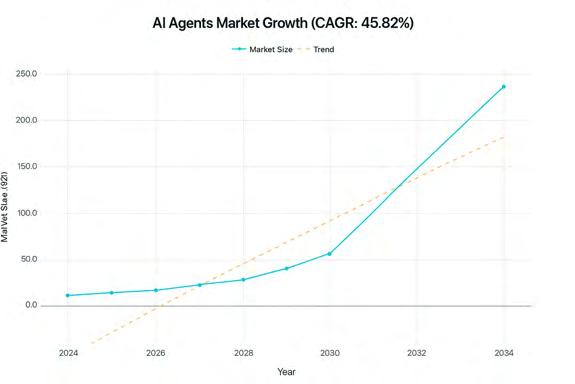
AI Agents Market Growth Projection (2024-2034)Exponential growth with 45.82% CAGR
Unlike traditional automation that follows rigid rules, AI agents possess the remarkable ability to perceive their environment, process complex information, make contextual decisions, and learn from experience. They represent the evolution from reactive systems to proactive intelligence that can handle ambiguity, adapt to change, and optimize outcomes in real-time.
Customer Service: Leading the Charge Customer service has emerged as the frontrunner in AI agent adoption, with 85% of progressive organizations already implementing these systems. From my experience in marketing technology, this makes perfect sense—customer interactions generate vast amounts of data while requiring immediate, personalized responses.
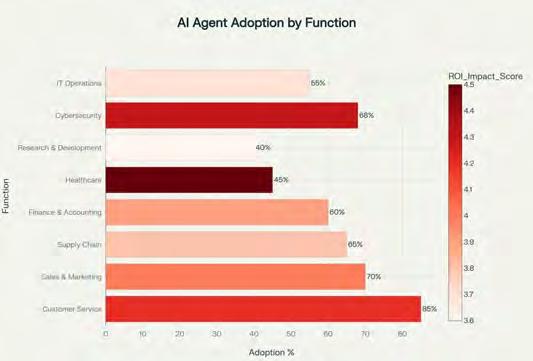
AI Agent Adoption Rates by Business FunctionCustomer service leads with 85% adoption Modern AI agents in customer service go far beyond chatbots, handling complex problem-solving scenarios while accessing multiple systems simultaneously to deliver personalized solutions. Organizations report up to 90% reduction in first-response times and 35% cost savings compared to traditional support models.
Marketing and Sales: Intelligence-Driven Revenue Generation
In my current role, I've seen how AI agents transform marketing operations by analyzing consumer behavior patterns, crafting personalized messages, and dynamically adjusting campaigns in real-time. These systems seamlessly integrate with CRM platforms, customer data platforms, and analytics tools to create unified, intelligent marketing ecosystems.
The most significant value lies not in replacing human creativity but in amplifying strategic thinking
AI agents handle analytical heavy lifting, allowing marketing professionals to focus on strategy, creative development, and relationship building.
AI agents are revolutionizing operations across multiple business functions, from supply chain optimization to financial services. In supply chain management, these systems autonomously manage inventory levels, predict demand fluctuations, and coordinate between suppliers in real-time. Financial services leverage AI agents for transaction monitoring, fraud detection, and automated reconciliation while ensuring regulatory compliance.
Despite tremendous potential, AI agent implementation faces significant challenges that organizations must navigate carefully. Data quality and access management represent primary concerns, as these systems require high-quality, well-organized data to function effectively.
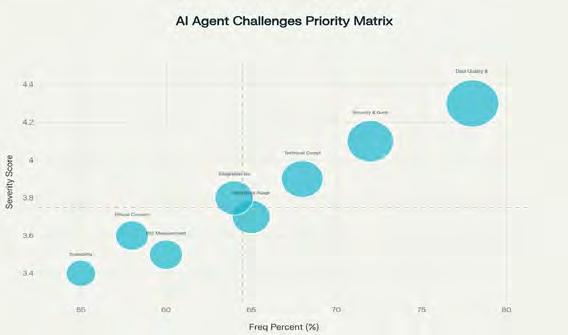
AI Agent Implementation Challenges: Frequency vs. Severity Analysis
Security considerations are paramount, given the autonomous nature of these systems. Organizations must implement comprehensive frameworks that protect against unauthorized access, privilege escalation, and manipulation attempts while maintaining functionality. From a change management perspective, workforce
adaptation requires careful planning. Success depends on clear communication about AI agent roles, comprehensive training programs, and establishing new workflows that leverage both human creativity and AI efficiency.


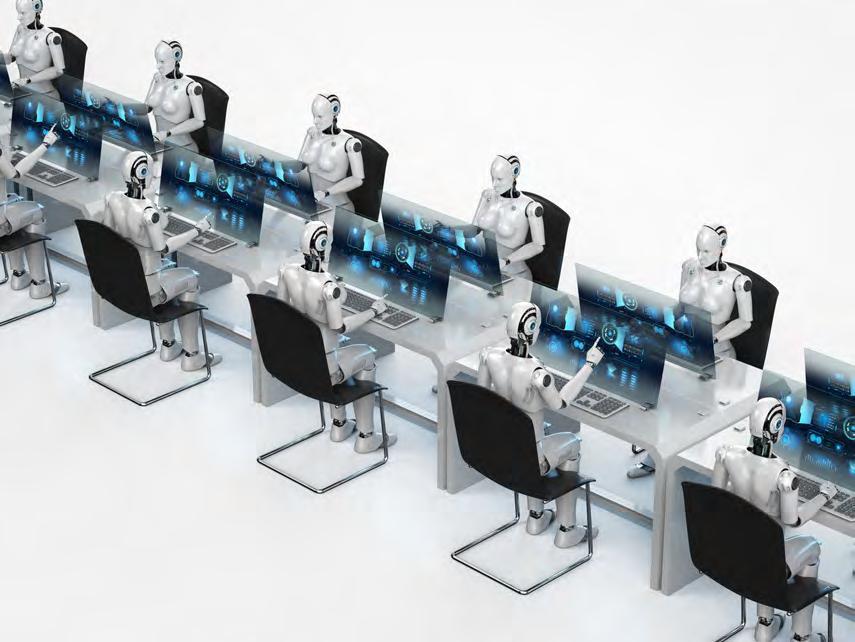
The evolution toward multi-agent systems represents the next frontier in autonomous intelligence. Unlike single-agent systems operating in isolation, multi-agent architectures enable collaborative intelligence where specialized agents work together to accomplish complex objectives.
By 2028, Gartner predicts that 33% of enterprise software applications will include agentic AI, enabling 15% of day-to-day work decisions to be made autonomously. This transformation will fundamentally alter workplace dynamics, creating new roles focused on AI agent management while eliminating routine tasks.

Workflow diagram of a multi-agent AI system, illustrating agent interactions.


Single-agent versus multi-agent AI systems.
Based on my experience implementing marketing technology solutions, successful AI agent deployment requires a phased approach. Organizations must begin with comprehensive readiness assessments, evaluating data quality, governance structures, and cultural openness to AI adoption.

The implementation journey typically follows four phases: strategic readiness, business process integration, pilot implementation, and scaling optimization. Each phase requires careful attention to governance frameworks that AI autonomy with human oversight.
Technology platform selection is crucial, with frameworks like LangChain for orchestration, LlamaIndex for data retrieval, and Microsoft's Semantic Kernel for production-grade planning gaining prominence. The key is choosing solutions that integrate seamlessly with existing enterprise systems while providing scalability for future
Quantifying AI agent value requires comprehensive approaches that capture both direct cost savings and strategic value creation. Key metrics include time savings, cost reduction, revenue enhancement, and efficiency gains.
The ROI formula considers net benefits including cost savings and revenue enhancements minus total development, deployment, and maintenance costs. Organizations should also consider long-term strategic value, including competitive advantage and organizational learning capabilities.
Looking ahead, several trends will shape the AI agent landscape. Multi-agent systems will become mainstream, with organizations deploying sophisticated networks of specialized agents that collaborate seamlessly. The emergence of "agent-in-chief" systems will coordinate these networks while maintaining human oversight.
By 2028, Gartner predicts that 33% of enterprise software applications will include agentic AI, enabling 15% of day-to-day work decisions to be made autonomously. This transformation will fundamentally alter workplace dynamics, creating new roles focused on AI agent management while eliminating routine tasks.

Diagram of a Multiagent System Architecture
Regulatory frameworks will evolve to address transparency, accountability, and safety requirements. Organizations that proactively address these considerations will be better positioned to leverage AI agent capabilities while maintaining stakeholder trust.
Conclusion: Embracing Transformation
The AI agent revolution represents more than technological advancement—it signifies a fundamental shift in how we conceptualize work and human-machine collaboration. Success requires viewing AI agents not as replacements but as collaborative partners that amplify human capabilities.
Organizations that approach AI agent adoption strategically, with clear objectives and comprehensive planning, will establish foundations for sustainable competitive advantage. The autonomous revolution is here, and the question isn't whether to adopt AI agents, but how quickly and effectively to transform operations to leverage these powerful capabilities.
For business leaders, the time for preparation is now. The future belongs to those who can orchestrate effective collaboration between human creativity and artificial intelligence, creating synergies that exceed the capabilities of either alone.
Mr. Babu Chakraborty Head of Marketing & Digital Initiatives Sorigin Group
Mr. Babu Chakraborty, Head of Marketing & Digital Initiatives at Sorigin Group, brings over 18 years of Marketing Technology experience combined with advanced credentials MTech in AI and Data Science (MSc). His unique perspective bridges technical AI implementation with strategic business transformation, having witnessed firsthand the evolution from basic marketing automation to sophisticated AI-driven enterprise systems.

In 2025, autonomous AI selection has evolved from a technical choice to a boardroom priority. As agentic AI adoption accelerates at over 35% CAGR, CTOs are at the forefront of decisions that will shape the future of enterprise productivity, innovation, and resilience. Amid accelerating automation and rising complexity, choosing the right AI agent platform can determine whether digital transformation efforts succeed or stall.
A structured, research-driven framework can help CTOs navigate the complex matrix of autonomous AI tool selection, ensuring not just early wins, but long-term scalability and compliance.
Aligning Autonomous AI with Business Strategy
The foundation of any successful AI deployment begins with clarity of business objectives. Whether the goal is to enhance customer experience, reduce operational costs, or unlock new revenue streams, CTOs must collaborate with business leaders to define targeted use cases. These could include:
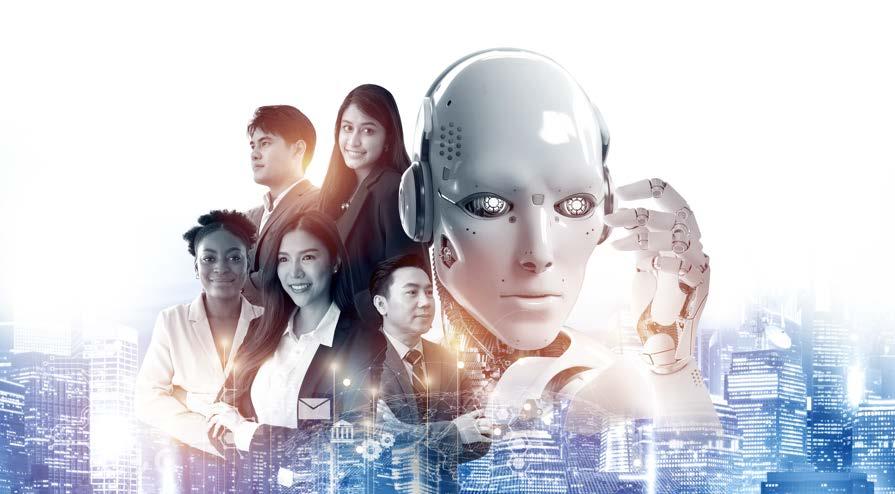
• Automating customer support workflows
•Accelerating agile software delivery
•Enhancing predictive analytics in supply chain management
Avoid the trap of adopting AI for novelty’s sake. Effective enterprises ground their evaluations in fit-for-purpose use cases with measurable KPIs, like resolution times, ROI impact, or user satisfaction. Every tool considered must align with strategic business needs, not just technical excitement.
CTOs leading in enterprise AI adoption use structured decision-making frameworks to minimize risk and ensure objectivity. Some commonly used models include:
•Rational Decision-Making: A step-by-step comparison based on predefined metrics (e.g., cost, scalability, security).
•Pugh Matrix: Scoring and ranking tools against a weighted criteria grid.
•Bounded Rationality: Optimizing within realistic constraints like budget, organizational readiness, and technical skill gaps.
Additionally, many enterprises form AI Centers of Excellence (CoEs) to guide evaluation, piloting, governance, and knowledge sharing across departments.

Recent benchmarks and industry studies outline a set of core capabilities CTOs should prioritize when evaluating AI agent platforms:
1. Technical Autonomy
The platform should independently execute complex tasks with minimal human intervention learning and adapting over time. Look for tools that leverage reinforcement learning, memory feedback loops, and dynamic goal setting.
2. Seamless Integration
Best-in-class platforms integrate smoothly with your existing tech stack. Tools offering drag-and-drop workflow builders, native connectors to SaaS apps, and open APIs simplify onboarding and reduce friction.
3. Enterprise-Grade Security & Compliance
Security cannot be an afterthought. The platform should support:
•Role-based access control
•End-to-end encryption
•Compliance with GDPR, HIPAA, SOC2
•Secure audit trails and logging
Zero-trust architecture and browser-native security are becoming table stakes.
4. Scalability & Customization
The tool must be flexible enough to evolve with your business. This includes hybrid cloud deployment, multi-tenant support, and the ability to customize workflows based on domain-specific needs.
5. Vendor Maturity & Ecosystem Support
Evaluate the vendor’s track record—community activity, update frequency, support infrastructure, and roadmap transparency. Striking a balance between innovation and stability is key.
6. User Experience & Adoption
A platform is only as good as its usage. Choose tools that offer intuitive interfaces, real-time feedback, and low false positive rates to ease change management and drive adoption.
Leading platforms in 2025, such as Microsoft Autogen, Relevance AI, and Cognosys, consistently score high across these dimensions.
Continuous Benchmarking: Stay Ahead of the Curve
The best CTOs know that tool evaluation doesn’t stop at procurement, it must continue into production environments.
Start with limited pilots focused on high-impact areas like IT service automation or finance operations. Key steps include:
•Tracking business-aligned KPIs (e.g., defect rate reduction, time savings)
•Collecting user feedback from both technical and non-technical stakeholders
•Monitoring for drift between vendor claims and actual output quality
This allows for agile iteration and ensures only high-performing tools are scaled.
Autonomous AI raises new challenges around governance, transparency, and ethical accountability.
CTOs should:
• Define standards for explainability and model bias mitigation
•Ensure auditability across agent actions and decisions
•Set up human-in-the-loop checkpoints for sensitive workflows
Today’s top platforms now offer built-in scenario testing, ethics dashboards, and usage transparency to support enterprise-grade governance.
Successful AI implementation is as much about people as it is about platforms. Equip teams with:
•Tailored training programs
•Clear internal communications on AI impact and roles
•Ongoing support to bridge the capability gap
Creating internal AI champions can ease transitions and boost organization-wide adoption.
The AI landscape is evolving at lightning speed. CTOs must adopt dynamic evaluation models, benchmarking tools regularly against:
•New market entrants and innovations
•Evolving regulations
•Changing business needs
Annual or biannual reassessments can prevent vendor lock-in and ensure long-term agility.
Choosing the right autonomous AI tool in 2025 is a high-stakes decision with organization-wide implications. By anchoring decisions in clear business goals, adopting structured evaluation models, piloting rigorously, and building for security and scale, CTOs can unlock real enterprise value from agentic AI.
As one-third of enterprise software is forecasted to embed autonomous AI agents, those who lead with Piloting and









Indian companies have long used basic automation tools like chatbots and workflow software to cut costs and handle routine work. But these tools have limitations and can't adapt to changing situations.
Today's business world needs smart systems that can think and act independently. This is where Agentic AI comes in.
Indian companies have progressed through three stages: simple workflows (Zapier-like tools), robotic process automation (UiPath), and basic AI chatbots (WhatsApp bots). These tools helped but couldn't handle unusual situations, adapt to changes, or work collaboratively.
Agentic AI acts like a smart assistant that can make independent decisions, learn from experiences, work with other systems, and solve problems without human help. Think of it as a smart employee who never sleeps and continuously improves.
Rising Customer Expectations: Customers expect seamless, personalized experiences across all touchpoints. Traditional automation can't connect these experiences - Agentic AI can.
Talent Challenges: training costs and performance inconsistencies. Agentic AI agents provide consistent 24/7 performance.


Global Competition: Indian IT services need faster delivery, better quality, and lower costs. Agentic AI delivers all three.
Banking: Instant Loan Processing
Traditional: Personal loan applications take 5-7 days with multiple manual checks.
Agentic AI: Instantly checks credit scores, verifies income, assesses risk using 50+ data points, and approves/rejects in 2 minutes while sending WhatsApp updates.


Traditional: Manual inventory tracking often leads to stock-outs during festivals.
Agentic AI: Monitors sales patterns, predicts seasonal demand, automatically places supplier orders, adjusts competitive pricing, and coordinates with logistics.
Healthcare: Patient Care Coordination
Traditional: Patients make multiple calls and visits to coordinate between doctors, labs, and pharmacy.
Agentic AI: Automatically schedules appointments, sends medicine reminders, coordinates test results, alerts doctors about critical values, and handles insurance claims.
Agentic AI has five key capabilities: independence (works without constant supervision), memory (remembers past interactions), tool usage (operates different software systems), smart thinking (plans ahead and adapts), and teamwork (collaborates with other AI agents and humans).
Messy Data: Many companies store data in Excel sheets, old systems, and paper documents. Agentic AI can read unstructured data and extract information from Hindi invoices, handwritten forms, and legacy systems.
Compliance Requirements: Banking and finance companies must follow strict RBI rules. Supervisor AI agents monitor other agents, ensuring rule compliance and maintaining detailed records.
Limited Technical Teams: Many businesses want advanced AI capabilities without large IT teams. New platforms enable AI agent creation without complex coding.
Cultural Nuances: Indian customers communicate uniquely, mixing languages and using cultural references. AI agents trained on Indian data understand context, emotion, and cultural cues.
Companies must address four key risks: AI making mistakes (use supervisor agents for important decisions), data privacy (implement strong encryption and access controls), lack of human touch (design clear escalation paths), and unclear decision-making (maintain detailed logs and use explainable AI).
Leading Indian tech companies are leveraging AI to transform customer service and security. Meesho uses an AI voice agent to handle thousands of daily customer calls in English and Hindi, achieving high resolution rates and reducing costs. Zerodha’s AI agents answer customer queries instantly, cutting response times from hours to seconds. Razorpay employs AI to detect fraud in real-time, minimizing false positives while catching more actual fraud. These innovations have improved efficiency, customer satisfaction, and safety. AI is rapidly becoming a game-changer in India’s digital economy.
For companies ready to embrace Agentic AI: start small with one specific process, choose the right tools (platforms like LangGraph, CrewAI, and Autogen), focus on cleaning up data, plan for human supervision, and measure results in speed, accuracy, and customer satisfaction.

Agentic AI represents a fundamental shift in business operations. For Indian companies facing pressure to do more with less, it's becoming essential for survival and growth.
India has a unique opportunity to lead in AI adoption, just like we leapfrogged to UPI payments and digital India. The key is reimagining how work gets done - instead of asking "What can I automate?" ask "What can I delegate to an AI agent?"
Companies that embrace this shift early will have significant advantages in efficiency, customer responsiveness, and future readiness. The question isn't whether Agentic AI will transform Indian business - it's whether your company will be ready.

Vaibhav Goyal is the Co-founder of Predixion AI, a next-generation conversational AI agent platform focused on transforming debt collection. With over 20 years of experience in digital product management and engineering, Vaibhav has successfully delivered 25+ commercial-grade digital products, establishing himself as a seasoned DeepTech product leader.
An entrepreneur at heart, he launched an omnichannel book retail business at the age of 24, scaling it to ₹1 crore in revenue within just one year. Over the years, Vaibhav has collaborated with multiple startups across AI, deep tech, SaaS, enterprise, education, healthcare, e-commerce, social media, and content/OTT, contributing to sustainable business models, product innovation, growth strategies, organizational development, and capital raising across various stages.
A prolific writer and a recognized LinkedIn India Top Voice in AI, Vaibhav is also a sought-after keynote and panel speaker at leading AI forums across the country. He holds a B.Tech from IIT Madras and an MBA from SP Jain Institute of Management & Research, Mumbai.





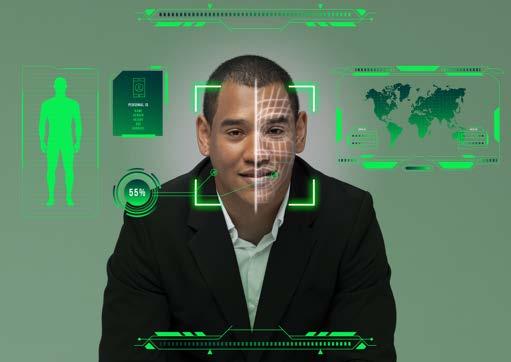
The world is shifting, but the pace of the changes is no longer slow. Industries familiar with the quiet progress in tech adoption now embark on more adventurous, complex, and radically transformative initiatives, all thanks to agentic artificial intelligence, or agentic AI. This technological improvement encourages all stakeholders to shift from a reactive to a proactive approach, embracing the philosophy of AI-assisted ideation and problem-solving.
Since AI systems customized for industrial applications can now act with greater autonomy and provide context-based insights, professionals must incorporate them into their toolkits. Doing so promises faster execution of new, purpose-centric initiatives.
At the same time, this shift demands revisiting leadership in this age of autonomous, more intuitive AI platforms. Both experienced and aspiring leaders must broaden their understanding of how machines make decisions, similar to humans, and whether their output is acceptable or requires improvement. Stakeholders willing to co-create sustainable, ethical solutions with non-human agents must also view autonomous, proactive AI as a strategic force rather than treating it as a threat to their dominance.
A Brief About Agentic AI
Agentic AI is an umbrella term that describes computing systems mimicking human agents’ capabilities. Instead
of the limited, reactive scope where machines wait for instructions, AI agents can monitor changes in data, alert users, and take necessary precautions. Yes, they can perceive the pros and cons of a situation. Later, agentic AI will decide what measures to employ if the issues are minor. Otherwise, they can inform appropriate human supervisors about more complex problems with a list of potential troubleshooting strategies.
In short, AI agents can act with goals in mind. This strength differentiates them from traditional software suites. After all, older, legacy programs often waited for user input and focused on executing rigid scripts. Today, using those inflexible environments is no longer necessary. Enterprises can thoroughly audit their internal and client operations for opportunities to integrate agentic artificial intelligence.
Those integrations might be available on individual machines if on-premises data processing is a priority. Still, most stakeholders stand to gain cost reduction and external expertise advantages by shifting to cloud-hosted alternatives. Remember, as the research into optimizing agentic AI for each industry goes further, the AI agents will adapt, learn, and operate with a much greater increasing independence.
Agentic AI can systematically negotiate contracts. Its various implementations can build and debug code. They will offer designs that will assist decision-makers in crafting product roadmaps. Whether organizations seek better marketing strategies or quicker customer grievance redressal, context-appropriate AI responses can significantly aid them.
The above use cases are not limited to science fiction clips or highly controlled lab settings. More and more globally renowned industry leaders have made AI agents live on their commercial and internal IT systems. As a result, the era of rule-restricted, passive automation is coming to an end sooner than estimated.
For decades, automation had a finite scope. It meant many rules, fixed scripts, and repeatability across corporate activities. Think of compliance, supply chain, finance, and IT infra development. Your team wrote a program that followed instructions. Everyone knew what to expect from each tool. That was all right for manufacturing, logistics, customer service, and many other processes.
However, modern scenarios are more complex. Consequently, agentic AI that goes beyond following a fixed playbook because it solves new problems and navigates ambiguity is more valuable than ever. Besides, it can make trade-offs like a human manager or assistant would do. This agentic shift also creates new workflows where human workers are less likely to experience burnout. Given the rising demand for innovative solutions, this change needs to be welcomed by leaders and working professionals.
A prime example of this proactive autonomy is ASTRA (Agentic System for Tracking, Research and Analysis), a revolutionary AI platform transforming business intelligence workflows. Developed to tackle prevalent challenges such as information overload, consistency issues across analyses, knowledge silos, and scalability limitations, ASTRA leverages a sophisticated multi-agent architecture built with Lang Graph. It fundamentally accelerates the report creation process while enhancing analytical depth and consistency. By enabling capabilities like dynamic template generation, question-driven content formulation, and multi-source intelligence gathering, ASTRA frees analysts to focus on strategic interpretation and recommendations. This platform exemplifies the intelligence amplification approach, transforming overwhelming data into structured, actionable insights and continuously building organizational knowledge, thereby augmenting human capabilities rather than replacing them.
Although agentic AI changes power dynamics for the better, it affects enterprises’ legal, financial, and ethical risks. This trend is no different than what the corporate world has witnessed with analytics, robotics, and surveillance compliance. After all, many stakeholders have already demonstrated an unwillingness to support some AI integration initiatives, citing privacy and data ethics concerns.
Some critics also promote the concept that all artificial intelligence breakthroughs will threaten employment opportunities. Others question the reliability of AI systems due to reports showing biases in AI output that an unsuspecting individual might use to make crucial decisions. Governments and law enforcement are also perplexed by intellectual property rights (IPR) or copyright implications of AI-powered derivative works of otherwise protected media.
The above circumstances emphasize the need to prioritize listening to stakeholder feedback and optimizing agentic AI adoption strategies. Leaders must patiently educate workers, consumers, and investors on the actual gains and risks of artificial intelligence integrations. Simultaneously, pretending as if criticism lacks merit and forcing AI tech features on consumers and other stakeholders with no option to opt out will inevitably land the organizations in hot waters.
Other considerations have less to do what outsiders say and more to do with what you want to achieve. In addition to responsible, ethical agentic AI utilization, periodic reviews for goal alignment are vital. Many nuances in public relations, multicultural workforce development, marketing, compliance, and pricing strategies will still be missed by AI. Essentially, leaders must find agentic AI champions within the organization to encourage the co-creation or human-in-the-loop approach. It helps mitigate those risks.
The Agentic Shift Fueled by AI Agents and Human-in-the-Loop Models isHere to Stay and to Help You Thrive
The invention of the wheel streamlined the transportation of physical goods, like agricultural consumables, health supplies, or construction materials. It also improved the moving of worker camps, defense units, academic works, and diplomatic representatives between distinct locations. Today, we have more advanced means of traveling that continuously impact cultures, but the wheel has never lost its significance.
The leaders, their employees, independent vendors, political stakeholders, non-governmental organizations, scholars, consumers, and investors are also actively pursuing better rewards via numerous means. Agentic AI is here to reduce the hardships they encounter in their journeys. It will mostly change the nature of work. So, yes, it will force all stakeholders to revisit their understanding of intelligence, imagination, problem-solving, and human-machine interactions.
However, the use of AI agents will also increase compliance challenges and the need for data ethics. Artificial intelligence has existed for a long time, but the advent of generative AI services and chatbots has made the entire world more aware of its potential. If leaders wish to benefit from such advancements, addressing criticism, establishing transparent policies, and fostering human-in-the-loop workflows will be indispensable in this century and beyond.
Senior Vice President & Head of Data Analytics
SG Analytics
Vignesh CV (Senior Vice President and Head of Data Analytics) - An industry leader with over 20 years in data analytics and consulting. Vignesh has built and scaled capabilities across organizations like Hewlett Packard, BRIDGEi2i, Ninjacart, and most recently, SG Analytics, where he leads our data analytics strategy and delivery. In the past few months, Vignesh has conducted insightful workshops with leading industry bodies like NASSCOM, focusing on how Generative AI And AI Agents are reshaping business and technology landscapes. His sessions combine technical expertise with practical frameworks making complex concepts actionable for both business and tech stakeholders. From advising Fortune 500s to building AI-first cultures, his core strength lies in driving value-led innovation—something highly relevant for enterprises to scale decision intelligence and operational efficiency.


Artificial Intelligence has already shifted from being a back-office enabler to a front-line business driver. With the arrival of Agentic AI, systems capable of understanding goals, making autonomous decisions, and collaborating with other agents, the workforce challenge is no longer just “learning AI tools.”
In the Agentic AI era, employees must know how to
Understanding Agentic AI - A Skill in Itself
Before an employee can work effectively with Agentic AI, they must understand
•The difference between automation, traditional AI, and agentic AI
•Core concepts: autonomy boundaries, multi-agent systems, human-in-the-loop oversight
•Business applications: from predictive maintenance


In the Agentic AI world, every role becomes tech-adjacent. Non-technical professionals must gain functional literacy in
• Prompt engineering and task orchestration
• Interpreting AI outputs and data-driven recommendations
• Understanding system limitations, biases, and failure modes
For example, a procurement manager doesn’t need to code an AI agent but must know how to deploy, monitor, and adjust one that negotiates supplier contracts autonomously. Technical Literacy
The rise of autonomous systems will create entirely new career paths
•AI Orchestration Specialist - Designs workflows for multi-agent collaboration
• Autonomy Governance Officer - Monitors compliance, fairness, and safety of autonomous systems
•AI Risk Analyst - Identifies operational and reputational risks from autonomous decision-making
•Human-AI Collaboration Coach - Trains teams to integrate AI into daily work patterns
Organizations that start training for these roles now will lead in adoption maturity.
The rise of autonomous systems will create entirely new career paths
AI Interaction Skills
• Writing effective prompts for complex, multi-step objectives
• Using conversational interfaces for operational decision-making
Data & Analytics Fluency
•Reading dashboards that blend human and AI insights
• Understanding confidence scores, anomaly alerts, and AI reasoning traces
Governance & Ethics Competence
• Knowing when to override AI decisions
• Ensuring equitable service delivery across demographics
Scenario Thinking & Adaptability
• Simulating “what-if” outcomes with AI tools
• Adapting workflows as agents evolve through learning
Strategies
Step 1 – Conduct an AI Readiness Audit
Identify which roles will interact with Agentic AI in the next 12–24 months.
Step 2 – Tiered Learning Pathways
•Foundational: AI literacy for all staff
•Functional: Role-specific AI integration skills
•Advanced: Agent design, orchestration, and governance
Step 3 – Learning-by-Doing
Deploy safe, sandboxed AI agents for employees to experiment with real scenarios before full production use.
Step 4 – Build Internal AI Champions
Select early adopters to mentor peers, run AI knowledge sessions, and test new workflows.
Leadership’s Role in the Upskilling Transformation
Executives must lead by example
• Using AI agents in their own workflows
• Demonstrating transparency about AI’s capabilities and limits
• Supporting risk-taking in adopting new AI-powered methods
Key leadership shift: Move from “managing employees” to “orchestrating humans and AI agents together.”



Because Agentic AI evolves rapidly, training can’t be a one-off event. Organizations need
• Always-on learning platforms with micro-updates on AI tools and methods
• Cross-functional AI guilds or communities of practice
• Quarterly simulations of AI-driven business disruptions and opportunities
Avoiding the Two Big Pitfalls
Pitfall 1: Over-automation without human skill growth
This creates a dependent workforce unable to operate without AI — dangerous in failure scenarios.
Pitfall 2: Fear-driven under-adoption
Avoidable if employees feel confident and empowered through early exposure and training.
A global manufacturing firm introduced autonomous quality inspection agents on its assembly line.
Phase 1: All line supervisors trained in AI basics and data interpretation
Phase 2: Selected staff learned to adjust agent decision parameters
Outcome: Defect detection speed doubled, false positives dropped by 18%, and employees reported higher job satisfaction due to reduced repetitive tasks.
Agentic AI adoption isn’t just a corporate challenge -it’s a workforce transformation issue for entire economies
• Governments can fund national AI literacy programs
• Universities can embed agentic AI coursework into all disciplines, not just STEM
• Public-private partnerships can create AI apprenticeship models for real-world learning
Agentic AI will handle many operational tasks with superhuman efficiency, but judgment, ethics, empathy, and creativity remain human domains.
Upskilling in the AI era is not about competing with machines - it’s about mastering the partnership. Those who learn to guide, govern, and grow alongside AI agents will not just survive the transition -they’ll lead it.
The question isn’t if you should start upskilling for Agentic AI - it’s whether you can afford not to.


Your Gateway to the AI-Ready Workforce
The Workforce Is Evolving. Are You?
In the coming decade, AI won’t just support your work - it will alongside you. Agentic AI think, decide, and act autonomously. already shifting to AI-powered, self-optimizing operations they need professionals who can
The Agentic AI Mastery Program by Skillzza equips you to
• Collaborate with AI Agents
• Govern & Guide Autonomy
• Integrate AI Into Business Systems
• Lead the Agentic Workforce

4 Weeks | Live Hands-On

• Professionals in technology, strategy, product, operations, consulting
• Entrepreneurs & founders
• Change agents driving digital transformation Who Should Enroll?






For decades, machines have obeyed without reason or thought. They’ve responded to commands, automated singular tasks, and helped us move faster but always under direct, explicit human supervision. The idea of true collaboration between humans and machines has remained just that: an idea. Until now.
We’re entering a new era of computing, one where machines don’t just assist, they understand, decide, and act. The future is exciting because we will be experiencing what is commonly referred to as Co-Intelligence.This is the story of how we got here, where we are today, and what’s coming next.


In the preLLM world, software automation was rulebased and deterministic. Robotic Process Automation (RPA), macros, and scripts drove productivity gains by mimicking keystrokes or workflows, but they lacked understanding. They were brittle, unable to adapt to changes in interfaces or intent, and dependent on exhaustive programming. The software had predictable inputs and was expected to provide deterministic outputs and any “unknown” input was handled through an error handling mechanism, thereby ending the process flow. This abrupt ending made the automation feel incomplete and sometimes inconsiderate to the user.
At best, these systems were obedient servants. At worst, they broke when anything changed. There was no intelligence, no reasoning, just rote execution.
The arrival of large language models (LLMs) changed the landscape. For the first time, machines could parse ambiguity, understand nuance, and respond in natural language. This gave birth to a new generation of productivity tools, copilots, and AI chat interfaces.
ChatGPT, Claude, Gemini, and others proved that language could be a universal interface reducing friction between humans and machines.
English became the new programming language. These models didn’t just follow commands; they held conversations, summarized information, and answered open-ended questions. But they were still reactive. The user had to know what to prompt and how to prompt. The AI had to wait while the user went on this journey of self discovery or rapid relearning.
The interface evolved, but the architecture was still passive.
The Agent Shift: From Assistants to Actors
The next step was obvious: if language could be understood, could machines also take action? This sparked the rise of agents which are programs designed to perform tasks autonomously. Early standalone agents tackled simple objectives: book a meeting, scrape a website, summarize a PDF. Useful, but narrow.
Then came a wave of general purpose agent platforms. OpenAI’s GPT Agents, tools like AutoGPT, and players like Manus began exploring autonomy across apps and use cases. These agents didn’t just respond, they reasoned. They decomposed goals into subtasks, made API calls, navigated UIs, and looped their actions based on results.
It was a breakthrough, but one constrained by its architecture. Most of these agents operated in the cloud, disconnected from the system they were meant to control. That limited their speed, context awareness, and realworld applicability.
We’re now on the cusp of something bigger: the emergence of device-native AI that doesn’t just react but proactively collaborates. This is what we call
Computer-Use AI: an intelligence layer that lives on your machine, sees what you’re working on, understands your intent, and takes initiative.
This new class of AI goes beyond chat. It coordinates across your system, automates complex workflows, and adapts in real time. Users no longer need to prompt every step. You give high-level direction and the AI handles the how.
At Ravian, we’ve been building towards this future.
Our platform is a general purpose, device-native AI designed to turn ordinary machines into intelligent teammates. Unlike cloud first agents, our system integrates deeply with local interfaces, enabling low latency execution, high contextual accuracy, and complete privacy.
It can generate and run code. Navigate the browser. Operate system apps. Manage documents. Coordinate across software suites. And it does this autonomously planning, acting, and learning on its own.
At the heart of our architecture is a layered intelligence model that allows the AI to reason through tasks, adapt to changing conditions, and continuously improve its decision-making. This is what enables real agentic behavior, not just prompt-response interaction.
Why Native Matters
Being device native is not just a technical choice, it's a philosophical one. Realtime computing demands proximity. Cloudbased agents introduce latency, cost, and privacy tradeoffs. A native model solves these.
Our system runs on the edge. That means:
•Subsecond latency
•Full contextual awareness
•Zero cloud inference costs
•Data never leaves the device
This opens the door to use cases previously out of reach:
•Developers generating, testing, and deploying code autonomously
• Teams automating workflows across SaaS tools without writing a single script
•Enterprises enforcing data sovereignty while still benefiting from cutting-edge AI
•Creators designing, drafting, and publishing content without toggling apps
The New Collaboration
This is not the AI of yesterday, a helper in the corner, waiting for commands. This is a true digital twin. It
doesn’t just do what you say. It understands what you’re trying to achieve and figures out how to get there. That’s Ravian AI - the future of HumanAI collaboration: not command-based assistance, but co-ownership of outcomes.
Co-Founder & CEO
Ravian AI
Dheeraj Gupta is the co-founder and CEO of Ravian AI, where he is leading the charge toward redefining human- AI collaboration. With over a decade of experience as a data scientist and AI architect, Dheeraj has worked across enterprise systems, intelligent automation, and real-time AI infrastructure. Before founding Ravian, he held leadership roles in both startups and global tech firms, building scalable AI systems and driving digital transformation. At Ravian, he is pioneering a new category of device-native AI that empowers machines to operate autonomously across everyday computing environments, moving beyond assistants to true collaborators.
Dheeraj is deeply focused on making AI not just powerful, but personal, private, and proactive.


The pharmaceutical Active Pharmaceutical Ingredient (API) industry is undergoing a significant digital transformation, propelled by cutting-edge developments in automation, data analytics, and artificial intelligence (AI). This article delves into the digital evolution of the API sector, focusing on smart manufacturing, digital supply chain integration, and advancements in regulatory compliance. It also discusses the challenges companies face and the strategic opportunities that digitalisation presents for future growth and resilience.
Introduction
The pharmaceutical API industry plays a foundational role in global healthcare, supplying the essential chemical compounds that form the active components of medications. As the demand for cost-effective, high-quality drugs grows, so too does the pressure on manufacturers to improve efficiency, reduce operational costs, and meet stringent regulatory requirements.
Digital technologies are revolutionising every facet of

API production — from manufacturing and supply chain logistics to compliance and quality assurance. By embracing digitalisation, pharmaceutical companies can not only streamline operations but also unlock new levels of innovation and responsiveness.
Smart Manufacturing & Industry 4.0
The rise of Industry 4.0 has introduced a new era of intelligent manufacturing within the API sector.
By leveraging Internet of Things (IoT) devices and AI-powered predictive analytics, companies can monitor production lines in real time, foresee equipment failures, and optimize production schedules.
Automation in quality control is another transformative element, enabling manufacturers to minimise variability, enhance consistency, and maintain stringent quality standards without increasing costs.
A digitised supply chain ensures greater transparency and agility. Blockchain technology is being adopted to improve traceability, combat counterfeit APIs, and ensure product authenticity across global markets. Meanwhile, cloud-based platforms allow for real-time data sharing and collaboration between suppliers, manufacturers, and distributors — improving decision-making and reducing lead times.
Machine learning and big data analytics are streamlining drug development processes, particularly in API formulation. These tools analyse vast datasets to identify optimal process parameters, reduce experimental cycles, and cut down on raw material waste. The result is a more efficient pipeline from R&D to production.
Digital tools are also modernising regulatory compliance. Electronic documentation and AI-driven monitoring systems facilitate faster audit processes, ensure adherence to global standards, and enhance pharmacovigilance by tracking adverse events with greater accuracy and speed.
Despite the promise of digitalisation, the path forward presents several obstacles:
•Cybersecurity Risks: As systems become more connected, the risk of cyberattacks grows. Robust cybersecurity frameworks are essential to protect sensitive data and ensure business continuity.
•High Capital Investment: Transitioning to digital platforms requires significant financial resources, which may be challenging for smaller players in the industry.
•Talent Gaps: The successful implementation of digital systems depends on a workforce skilled in data science, AI, and digital operations—highlighting the need for targeted training and recruitment strategies.
The future of the API industry is increasingly intertwined with advanced technologies. AI will continue to evolve, playing a larger role in predictive modelling for API synthesis. Digital twin technologies — virtual replicas of physical manufacturing processes — are set to revolutionise process optimisation and real-time problem-solving.
To sustain this momentum, collaboration between policymakers, regulators, and industry leaders is essential. Such partnerships can help create frameworks that support innovation while maintaining safety and ethical standards.
Digitalisation in the pharmaceutical API industry is not just an emerging trend — it is a fundamental shift that will define the future of medicine manufacturing. To remain competitive and compliant in a dynamic global landscape, companies must invest strategically in technology, talent, and cross-sector partnerships. Embracing this digital transformation will pave the way for a more efficient, transparent, and innovative pharmaceutical ecosystem.
Abhishek Rathi has over 13 years of valuable experience in international sales of pharmaceutical APIs. A techno-commercial professional, he excels in customer relationship management, business development, key account handling, and digital marketing. His proven ability to drive growth and build strong global partnerships has been instrumental in expanding business reach across multiple geographies.
In his current role, he leads the sales and business development efforts across global markets, including India. He manages key accounts and negotiates high-value contracts with some of the top pharmaceutical companies. With an eDiploma in Sustainable Business Strategy from Harvard Business School Online, Abhishek ensures his work aligns with the company’s core values, delivering quality and affordable healthcare to the world.
He remains committed to strengthening the company’s presence and credibility in the global

YOUR WEEKLY INSIGHT INTO TECHNOLOGY, INNOVATION & LEADERSHIP

Stay ahead of the curve with The Tech Lens – your curated source of the most impactful tech updates, tailored for CXOs, tech leaders, entrepreneurs, and AI enthusiasts navigating the ever-evolving digital landscape.
Each edition brings you: Breakthroughs in AI & Emerging Technologies
Insights on Enterprise
Innovation & Productivity Trends in Strategic Leadership & Decision-Making
Power-Packed Summaries
Delivered Every Saturday
Trusted by 25,000+ readers worldwide – including CIOs, founders, and digital transformation leaders.
Get your weekly deep dive – only from The Tech Lens For partnerships or sponsorships: Contact@cxotechbot.com
In 2025, “agents” moved from neat demos to production workloads. The bar rose from single-shot tool use to long-running, stateful, policy-aware systems that plan, act, learn, and interoperate with enterprise apps. The winners aren’t just big models, they're the platforms and frameworks that make agents observable, governable, and cost-efficient at scale.
LangGraph (by LangChain): Stateful agents at scale
What it is: The LangGraph Platform adds deployment, scaling, and monitoring to LangChain’s graph-based agent patterns (tools, memory, human-in-loop).
Why it matters: GA in May 2025 so it’s past beta churn and built for long-running, stateful agents you can actually ship.
Best for: Teams already prototyping in LangChain that now need reliability, retries, persistence, and observability in prod.
02

Microsoft AutoGen: Collaboration-first multi-agent systems
What it is: An open-source framework from Microsoft Research that treats agents as conversational collaborators with tools and memory.
Why it matters: Strong patterns for multi-agent debate, evals, and tool orchestration; fresh 2025 materials make it enterprise-friendly.
Best for: Research + product teams exploring multi-agent strategies (critic/solver, planner/executor) before locking into a platform.



CrewAI: Role-based, multi-agent “crews”
What it is: A framework for defining agents with roles, goals, tools, memory then orchestrating them into workflow crews.
Why it matters: Clear mental model, good docs, growing ecosystem; popular for go-to-market automations and research workflows.
Best for: Startup speed, marketing/research teams, and POCs that need multi-agent coordination fast.


What it is: Google Cloud’s managed service for building agents with pre-built tools (BigQuery, code interpreter, etc.), memory, and observability.
Why it matters: It natively recognizes third-party frameworks (LangChain, CrewAI) and exposes pricing knobs for compute/memory important for governance

Best for: Data/ML teams standardized on GCP needing unified security, logs, quotas, and org controls.

Bedrock Agents & AgentCore (+ Amazon Q Developer)
What it is: Bedrock’s multi-agent collaboration lets specialized agents coordinate under a supervisor; AgentCore (2025) adds security/governance primitives. Q Developer is AWS’s autonomous coding agent tightly integrated with IDEs and repos.
Why it matters: GA of multi-agent and new AgentCore make AWS a serious “agent fabric” for enterprises. Q Developer now executes builds/tests to validate code.
Best for: Enterprises committed to AWS needing agent security, policy, VPC isolation—and developers who want agentic coding in the IDE.



Microsoft Copilot Studio (multi-agent orchestration)
What it is: A low-code studio to create and publish agents across Teams, SharePoint, telephony/IVR and more; 2025 adds multi-agent orchestration and Fabric data agents.
Why it matters: Deep M365 integration and governance; ships where the users already work.
Best for: CIO shops on Microsoft 365 that need measurable productivity gains + compliance out-of-the-box.
Salesforce Agentforce
What it is: Salesforce’s platform for autonomous agents plugged into CRM/Service workflows, with a 2025 “Command Center” for observability.
Why it matters: If your revenue/service ops live in Salesforce, Agentforce reduces glue code and centralizes control.
Best for: Customer support, sales ops, and field service teams that must stay inside Salesforce.

IBM watsonx Orchestrate (Agent Builder + ADK)
What it is: IBM’s enterprise agent platform with agent builder, observability, data isolation (Premium plan) and a developer kit for local agents.
Why it matters: Strong governance and data-isolation features; 2025 releases add domain agents, plans, and security upgrades.
Best for: Regulated industries (finance, public sector, healthcare) prioritizing controls, isolation, and auditability.

OpenAI’s Agentic APIs (Responses API & Agents SDK)

NVIDIA NeMo + NIM Microservices (for agentic AI)
What it is: Model, guardrails, and pre-built inference microservices to run agentic apps on NVIDIA stacks cloud or on-prem.
Why it matters: Adds enterprise-grade APIs and guardrails; positions infrastructure + software for agent workloads.
Best for: Companies running GPU-dense environments or building low-latency agents with tight control over infra.

What it is: In March 2025 OpenAI introduced new APIs aimed at building agentic apps more directly (routing, tools, computer use).
Why it matters: If you rely on OpenAI models, these are the simplest building blocks to get “agentic” without rolling your own orchestration. (Note: Assistants API is on a deprecation path; plan migrations)
Best for: Teams already standardized on OpenAI that want native capabilities and a shorter build path.

“Agentic AI” in 2025 is less about magic models and more about operational excellence: long-running state, governance, tool security, and total cost. For most enterprises, the fastest path is cloud-managed agent platforms (Vertex, Bedrock, Copilot Studio, Agentforce) with open-source frameworks (LangGraph, AutoGen, CrewAI) for rapid iteration and infrastructure guardrails (IBM, NVIDIA) where compliance demands it. Pick your control plane first; the models will keep changing.

Necessary or Obsolete?

As the world steps deeper into the era of Agentic AI, systems that exhibit autonomy, intentionality, and adaptability, a pressing question arises: Are humans still required in the loop, or are we becoming obsolete in the decision-making process?
The traditional paradigm of Artificial Intelligence has always relied heavily on Human-in-the-Loop (HITL) frameworks, where human oversight ensures safety, ethical alignment, and corrective input. However, with the emergence of agentic AI systems, capable of goal-setting, multi-step planning, self-correction, and autonomous action, the role of human oversight is being fundamentally redefined.
The HITL model is a design approach where human involvement is embedded in critical stages of an AI system’s operation: data labeling, model training, decision auditing, and final execution. This model ensured explainability, ethical alignment, and accountability, especially in high-stakes applications like healthcare, finance, and defense.
In traditional machine learning, HITL filled the gap where machines lacked context or common sense. But in agentic AI, where agents can sense, plan, act, and learn from environments dynamically, the system begins to closely resemble a digital counterpart to human agency. This evolution demands a reassessment of where human intervention fits in or whether it fits at all.
Agentic AI systems are not just reactive; they are proactive. They can set goals, break them into subtasks, and continuously learn from outcomes. Tools like AutoGPT, BabyAGI, LangChain Agents, and enterprise-level cognitive agents are demonstrating levels of autonomy that allow systems to interact with APIs, analyze vast datasets, and even modify their code, all without explicit step-by-step instructions.
These agents no longer wait for instructions. They seek intent and act accordingly. In such a context, humans may not just slow down operations, they may become bottlenecks in agile environments where milliseconds matter.
Despite the growing sophistication of agentic systems, HITL continues to be indispensable in several key domains:
Autonomous agents lack intrinsic values or empathy. They may optimize for a goal but overlook nuances of human welfare, fairness, or unintended consequences. In such cases, humans are vital to guide agents within ethical boundaries, especially in areas like hiring, law enforcement, or medical diagnosis.
areas like hiring, law enforcement, or medical diagnosis.
2. Regulatory Compliance
Many industries are governed by stringent regulatory frameworks. An agent may act within its own logic but breach legal boundaries unknowingly. Here, humans play the role of compliance sentinels, ensuring AI-driven decisions don’t violate laws or industry norms.
3. Unpredictable Edge Cases
Agentic AI performs best in well-modeled environments. However, in chaotic, novel, or adversarial situations, such as during a cyberattack or geopolitical event, human experience, creativity, and intuition still outperform algorithms.
4. Trust Building
For many users, especially in sectors like finance, healthcare, or defense, trust in AI systems is still nascent. Human presence in the loop provides assurance, auditability, and the opportunity for override, all of which are critical for adoption.
Ironically, in high-speed environments such as algorithmic trading, predictive maintenance, or real-time logistics, human intervention can become a limiting factor. Agents can process terabytes of data, iterate on decisions, and implement actions in seconds, while humans require time for context, review, and approval.
For instance, in autonomous threat response in cybersecurity, agentic systems like CrowdStrike’s Falcon or Palo Alto Cortex XSIAM are now acting without human approval to neutralize attacks in real time. The logic is simple: waiting for a human to approve the countermeasure could mean a successful breach.
Similarly, in autonomous customer service systems, AI agents are learning to escalate only when the confidence threshold is low. Most interactions remain fully agent-managed, faster and more cost-effective than HITL models.
The Middle Path: Human-on-the-Loop and Human-out-of-the-Loop
Rather than a binary view of HITL versus no HITL, new architectures are evolving:
• Human-on-the-Loop
Humans monitor the system but do not directly intervene unless a threshold is breached. This is now common in autonomous vehicles, drone operations, and high-frequency trading.
• Human-out-of-the-Loop (HOOTL)
In low-risk, high-frequency tasks, agents operate entirely independently. For example, smart scheduling agents, inbox management tools, or content summarization bots now act autonomously across industries.
The design principle is risk-aligned oversight. The higher the potential harm, the greater the human involvement.
The most exciting frontier is not whether humans will be in the loop, but how we redefine the loop itself. In agentic ecosystems, humans may not be supervisors or auditors, but collaborators and co-agents.
We envision a world where: Humans provide strategic intent and agents handle execution
• Agents surface insights and recommendations while humans offer contextual judgment.
• Systems learn to adapt to individual human styles, preferences, and values, creating symbiotic, adaptive teams.
Rather than replacing humans, agentic AI may evolve to augment human capability, turning individuals into ‘superworkers’ supported by fleets of intelligent agents.
Human-in-the-Loop is not obsolete, it is evolving. In agentic ecosystems, the human role shifts from micromanager to architect, guide, and co-creator. The real challenge ahead is not whether we remain in the loop, but how we redesign the loop for a world where machines can think, act, and learn with purpose.
The future is not HITL or HOOTL - it is Human + Agentic Collaboration.